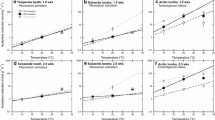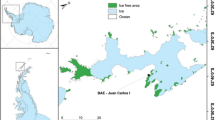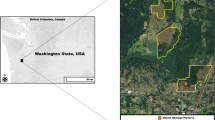Abstract
The activity pattern of the moss Hennediella heimii (Hedw.) Zand. was monitored over a period of 18 days during the austral summer season 2000/2001 at the Canada Flush in Taylor Valley, continental Antarctica. Provided with melt water from the massive Canada Glacier, the moss showed a constant potential photosynthetic activity during the entire measurement period. Permanently hydrated, the moss faced high light levels at surprisingly low moss temperatures, which is commonly supposed a deleterious situation for plants. The electron transport rate response of the moss to photosynthetic photon flux densities was linear at all temperatures and did not show a sign of saturation or photoinhibition. H. heimii seems to be well adapted to its environment and tolerates the ambient conditions without apparent harm. This might be due to the fact that mosses can acclimatise to high light conditions by building up highly effective non-photochemical quenching systems.





Similar content being viewed by others
References
Baker NR (1994) Chilling stress and photosynthesis. In: Mullineaux PM (ed) Causes of photooxidative stress and amelioration of defense systems in plants. CRC, Boca Raton, pp 127–154
Bilger W, Schreiber U, Bock M (1995) Determination of the quantum efficiency of photosystem II and of non-photochemical quenching of chlorophyll fluorescence in the field. Oecologia 102:425–432
Björkman O, Demmig B (1987) Photon yield of O2 evolution and chlorophyll fluorescence characteristics at 77 K among vascular plants and diverse origins. Planta 170:489–504
Demmig-Adams B, Máguas C, Adams WW III, Meyer A, Kilian E, Lange OL (1990) Effect of high light on the efficiency of photochemical energy conversion in a variety of lichen species with green and blue-green phycobionts. Planta 180:400–409
Fritsen CH, Grue AM, Priscu JC (2000) Distribution of organic carbon and nitrogen in surface soils in the McMurdo Dry Valleys, Antarctica. Polar Biol 23:121–128
Gauslaa Y, Solhaug K (1999) High-light-intensity damage to the foliose lichen Lobaria pulmonaria within a natural forest: the applicability of chlorophyll fluorescence methods. Lichenologist 32:271–289
Genty B, Briantais J-M, Baker N (1989) The relationship between the quantum yield of photosynthetic electron transport and quenching of chlorophyll fluorescence. Biochim Biophys Acta 990:87–92
Green TGA, Schroeter B, Kappen L, Seppelt RD, Maseyk K (1998) An assessment of the relationship between chlorophyll fluorescence and CO2 gas exchange from field measurements on a moss and lichen. Planta 206:611–618
Green TGA, Schroeter B, Sancho L (1999) Plant life in Antarctica. In: Pugnaire FI, Valladares F (eds) Handbook of functional plant ecology, vol 14. Dekker, New York, pp 496–543
Green TGA, Maseyk K, Pannewitz S, Schroeter B (2000a) Extreme elevated in situ carbon dioxide levels around the moss Bryum subrotundifolium Jaeg., Ber. S. Gall. in Antarctica. Bibl Lichenol 75:389–396
Green TGA, Schroeter B, Seppelt RD (2000b) Effect of temperature, light and ambient UV on the photosynthesis of the moss Bryum argenteum Hedw. in continental Antarctica. In: Davidson W, Howard-Williams C, Broady P (eds) Antarctic ecosystems: models of wider ecological understanding. Caxton, Christchurch
Heber U, Bilger W, Bligny R, Lange OL (2000) Phototolerance of lichens, mosses and higher plants in an alpine environment: analysis of photoreactions. Planta 211:770–780
Howard-Williams C, Vincent W (1986) Ecosystem properties of Antarctic streams. N Z Antarct Rec 6:21–27
Ino Y (1983) Estimation of primary production in moss community on East Ongul Island, Antarctica. Antarct Rec 80:30–38
Ino Y (1990) Field measurements of net photosynthesis of mosses at Langhovde, East Antarctica. Ecol Res 5:195–205
Kappen L (1988) Ecophysiological relationships in different climatic regions. In: Galun M (ed) Handbook of lichenology, vol 2, vol VII.B.2. CRC, Boca Raton, pp 37–100
Kappen L, Lange OL (1970) Kälteresistenz von Flechten aus verschiedenen Klimagebieten. Dtsch Bot Ges NF 4:61–65
Kappen L, Lange OL (1972) Die Kälteresistenz einiger Macrolichenen. Flora 161:1–29
Kappen L, Schroeter B (2002) Plants and lichens in the antarctic, their way of life and their relevance to soil formation. In: Beyer L, Bölter M (eds) Geoecology of Antarctic ice-free coastal landscapes, vol 18. Springer, Berlin Heidelberg New York, pp 327–373
Kappen L, Valladares F (1999) Opportunistic growth and desiccation tolerance: the ecological success of poikilohydrous autotrophs. In: Pugnaire FI, Valladares F (eds) Handbook of functional ecology. Dekker, New York, pp 9–80
Kappen L, Schroeter B, Green TGA, Seppelt R (1998) Chlorophyll-a-fluorescence and CO2 exchange of Umbillicaria aprina under extreme light stress in the cold. Oecologia 113:325–331
Lewis KJ, Fountain AG, Langevin P (1996) McMurdo Dry Valleys LTER: the role of terminus cliff melt in streamflow, Taylor Valley, Antarctica. Antarct J 189–190
Longton RE (1974) Microclimate and biomass in communities of the Bryum association on Ross Island, continental Antarctica. Bryologist 77:109–127
Lovelock CE, Osmond CB, Seppelt RD (1995) Photoinhibition in the antarctic moss Grimmia antarctici Card. when exposed to cycles of freezing and thawing. Plant Cell Environ 18:1395–1402
Moorhead DL (1996) McMurdo Dry Valleys LTER: stream discharge as a function of ambient temperature and incoming shortwave radiation in Taylor Valley, Antarctica. Antarct J 196–197
Noakes TD, Longton RE (1988) Pathways of water movement in relation to structure and micromorphology in Antarctic mosses. Polarforschung 58:125–138
Öquist G (1983) Effects of low temperature on photosynthesis. Plant Cell Environ 6:281–300
Pontaillier J-Y (1990) A cheap quantum sensor using gallium arsenide photodiode. Funct Ecol 4:591–596
Proctor MCF, Tuba Z (2002) Poikilohydry and homoihydry: antithesis or spectrum of possibilities? New Phytol 156:327–349
Rastorfer JR (1970) Effects of light intensity and temperature on photosynthesis and respiration of two East Antarctic mosses, Bryum argenteum and Bryum antarcticum. Bryologist 73:544–556
Schlensog M, Schroeter B (2000) Poikilohydry in antarctic cryptogams and its role for photosynthetic performance in mesic and xeric habitats. In: Davidson W, Howard-Williams C, Broady P (eds) Antarctic ecosystems: models for wider ecological understanding. Caxton, Christchurch, pp 175–182
Schlensog M, Schroeter B (2001) A new method for the accurate in situ monitoring of chlorophyll-a-fluorescence in lichens and bryophytes. Lichenologist 33:443–452
Schlensog M, Schroeter B, Sancho LG, Pintado A, Kappen L (1997) Effect of strong irradiance on photosynthetic performance of the melt-water dependent cyanobacterial lichen Leptogium puberulum (Collemaceae) Hue from the maritime Antarctic. Bibl Lichenol 67:235–246
Schlensog M, Schroeter B, Pannewitz S, Green TGA (2003a) Adaptation of mosses and lichens to irradiance stress in maritime and continental antarctic habitats. In: Huiskes AHL, Gieskes WWC, Rozema J, Schorno RML, van der Vies SM, Wolff WJ (eds) Antarctic biology in a global context. Backhuys Publisher, Leiden
Schlensog M, Pannewitz S, Green TGA, Schroeter B (2003b) Metabolic recovery of Continental Antarctic cryptogams after winter. Polar Biol (in press)
Schreiber U, Bilger W, Neubauer C (1994) Chlorophyll fluorescence as a nonintrusive indicator for rapid assessment of in vivo photosynthesis. In: Schulze E-D, Caldwell MM (eds) Ecological studies, vol 100. Ecophysiology of photosynthesis. Springer, Berlin Heidelberg New York, pp 49–70
Schroeter B, Sancho LG, Valladares F (1999) In situ comparison of daily photosynthetic activity patterns of saxicolous lichens and mosses in Sierra de Guadarrama, central Spain. Bryologist 102:623–633
Schwarz AMJ, Green TGA, Seppelt RD (1992) Terrestrial vegetation at Canada Glacier, Southern Victoria Land, Antarctica. Polar Biol 12:397–404
Seppelt RD, Green TGA (1998) A bryophyte flora for Southern Victoria Land, Antarctica. N Z J Bot 36:615–632
Smirnoff N (1993) Tansley review no. 52. The role of active oxygen in the response of plants to water deficit and desiccation. New Phytol 125:27–58
Smith RIL (2000) Plants of extreme habitats in Antarctica. In: Schroeter B, Schlensog M, Green TGA (eds) New aspects in cryptogamic research. Contributions in honor of Lutger Kappen. Bibl Lichenol 75. Cramer, Berlin, pp 405–419
Zander RH (1993) Genera of the Pottiaceae: mosses of harsh environments. Bull Buffalo Soc Nat Sci 32
Acknowledgements
S.P., M.S. and B.S. gratefully acknowledge financial support by Deutsche Forschungs-Gemeinschaft (DFG SCHR 473/4-3). Antarctica New Zealand is thanked for providing logistics both for the research in Antarctica and movements to Antarctica. The United States Antarctic Program is thanked for providing logistics in the Dry Valleys.
Author information
Authors and Affiliations
Corresponding author
Rights and permissions
About this article
Cite this article
Pannewitz, S., Green, T.G.A., Scheidegger, C. et al. Activity pattern of the moss Hennediella heimii (Hedw.) Zand. in the Dry Valleys, Southern Victoria Land, Antarctica during the mid-austral summer. Polar Biol 26, 545–551 (2003). https://doi.org/10.1007/s00300-003-0518-8
Received:
Accepted:
Published:
Issue Date:
DOI: https://doi.org/10.1007/s00300-003-0518-8




